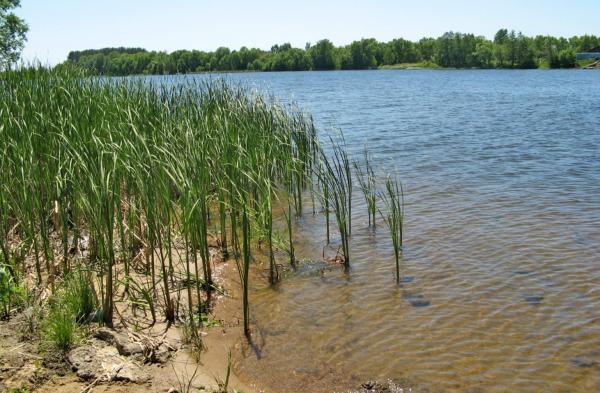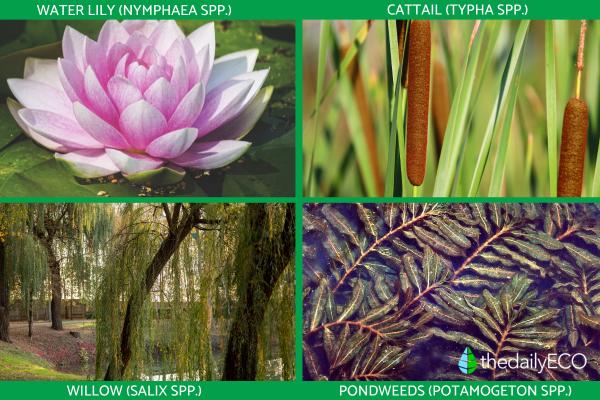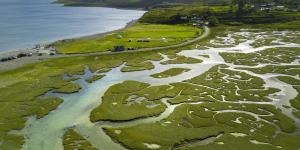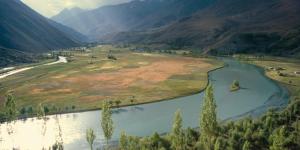What Is a Riverbank? Definition and Types


Riverbanks are ecosystems that line the shores of rivers, creating a seamless transition between the aquatic and terrestrial worlds. These dynamic zones are teeming with life, hosting a rich variety of flora and fauna uniquely adapted to the distinct conditions they offer. As well as providing shelter and sustenance for a wide range of wildlife, riverbanks serve as veritable lifelines for both nature and humanity.
In this article by thedailyECO, we explain what riverbanks are, their different types, the diverse plant and animal life they support, and the crucial ecological importance they hold.
What is a riverbank
Riverbanks serve as dynamic and diverse mixed ecosystems, playing a pivotal role in maintaining the balance between aquatic and terrestrial environments. These areas serve as habitats for an array of plants and animals, all of which rely on the presence of water and the unique environmental conditions found within these regions.
When exploring a riverbank, one will often encounter dense and specialized vegetation that has adapted to the ever-changing conditions. The proximity to water ensures that the soils remain moist and fertile, resulting in the growth of a variety of riparian habitats. These habitats can range from swamps and marshes to expansive riparian forests, with the specific type depending on the location and characteristics of the water body.
Beyond their significance for biodiversity, riverbanks also play a critical role in safeguarding water and soil quality. Functioning as natural filters, they effectively reduce erosion and retain sediment, nutrients, and pollutants, thus preventing these substances from entering the water body. Furthermore, riverbanks contribute to stabilizing the banks, a process crucial in preventing coastal erosion.
From a human perspective, riverbanks hold immense importance as well. Throughout history, people have been drawn to establish settlements near rivers and coasts, capitalizing on the abundant natural resources these areas provide, including fishing, agriculture, and transportation opportunities.

Zones of the riverbank
Certainly! The zones of the riverbank refer to distinct areas or habitats that can be identified based on their proximity to the water body and the specific environmental conditions they offer. Each zone supports different types of flora and fauna adapted to the particular characteristics of that zone. Broadly, the riverbank can be divided into four main zones:
Aquatic zone
This zone is directly within the water and comprises the areas that are submerged or frequently covered by water. Aquatic plants dominate this zone and have special adaptations to thrive in wet conditions.
Marsh zone
Moving closer to the banks, we encounter the marsh zone, which is characterized by wet and muddy areas. This zone experiences periodic flooding and has moist, nutrient-rich soils.
Riparian forest zone
As we move further away from the water's edge, we enter the riparian forest zone. This area is marked by the presence of trees and is characterized by a drier and more stable environment compared to the marsh zone.
It's important to note that the width and characteristics of each zone can vary depending on factors such as the river's flow, the surrounding topography, and the prevailing climatic conditions. These zones collectively form a complex and interconnected ecosystem that plays a critical role in supporting biodiversity, water quality, and ecological balance along the river's course.
You might also find interest in another article where we explain the definition of marshlands and explore how they are formed.
Flora of the riverbank
Riverbanks exhibit a remarkable variety of flora, all finely tuned to the distinct conditions found along rivers, lakes, and shorelines. These fertile and humid zones provide an ideal habitat for a diverse array of plants, each showcasing its own unique characteristics and adaptations. Broadly speaking, there are four distinct flora zones, ranging from within the water to the furthest point from the shoreline.
The three distinct flora zones in the riverbank are:
Aquatic zone
This zone is within the water and includes plants that have adapted to grow and thrive in submerged conditions. Examples of plants found in this zone are reeds, water lilies, and water lilies. These aquatic plants have specialized adaptations, such as long, thin roots that can absorb nutrients and oxygen from the water. Examples include: reed (Phragmites australis), water lilies (Nymphaea spp.), pondweeds (Potamogeton spp.), water milfoils (Myriophyllum spp.), and waterweeds (Elodea spp.).
Marsh zone
Moving closer to the banks, the marsh zone consists of dense and exuberant vegetation. In the more humid areas, you can find marsh vegetation like reeds, cattails, and rushes. These plants rise majestically above the water and play a crucial role in stabilizing the riverbank soil and preventing erosion through their strong root systems. Examples include: cattail (Typha spp.) and common rush (Juncus effusus).
Riparian forest zone
As we go further away from the water's edge, we encounter the riparian forest zone. This area is characterized by lush vegetation, with trees such as willow, alder, ash, and elm dominating the landscape. These trees are well-adapted to withstand periodic flooding and fluctuations in water levels. They provide shade and shelter for various animal species and contribute to water quality and the overall health of the surrounding ecosystem. Examples include: willow (Salix spp.), alder (Alnus spp.), ash (Fraxinus spp.) and elm (Ulmus spp.).
It's important to note that the composition of riverbank flora can vary significantly based on geographical location and prevailing climatic conditions.
Make sure to read this other article that discusses wetlands, their definition, the process of their formation, and the significance of these ecosystems.

Fauna of the riverbank
Riverbanks also support a rich and diverse fauna, intricately adapted to the unique conditions of these dynamic ecosystems along rivers, lakes, and shorelines. The fertile and humid zones of riverbanks provide an ideal habitat for various animal species, each displaying its own distinctive characteristics and adaptations. Similar to the flora, the fauna can be categorized into four distinct zones, reflecting their proximity to the water body.
Aquatic zone
The aquatic zone hosts a plethora of animals that thrive in the water or on its surface. Some examples of fauna found in this zone include:
- Fish: various species of fish such as bass, trout, and catfish, which rely on the river's waters for their survival and reproduction.
- Amphibians: frogs, toads, and salamanders, which utilize the water for breeding and shelter.
- Aquatic insects: water striders, dragonfly nymphs, and mayfly larvae are some of the insects that inhabit this zone, adapted to life in or near the water.
Marsh zone
As we move closer to the banks, the marsh zone becomes a haven for a diverse range of wildlife, including:
- Birds: many bird species find abundant food and nesting opportunities in the marsh, such as herons, ducks, and kingfishers.
- Small mammals: like muskrats and beavers, make their homes in the marshy areas and utilize the water for protection and sustenance.
- Reptiles: snakes and turtles can often be found in the marsh, taking advantage of the ample food supply and suitable basking spots.
Riparian forest zone
The riparian forest zone offers a habitat rich in resources, sheltering various animal species, such as:
- Birds of prey: raptors like owls, hawks, and eagles find ideal hunting grounds in the forested riverbank area.
- Larger mammals: like deer, raccoons, and foxes, thrive in the forested habitat, utilizing the abundant plant and animal resources available.
- Insects: numerous insects, including butterflies, bees, and beetles, play vital roles in pollination and nutrient cycling within the forest ecosystem.
The fauna of riverbanks varies significantly based on geographic location, climate, and the specific characteristics of the water body.
In this other article, you will learn about inland waters, including their defining characteristics and the significance they hold in our ecosystems.

Ecological importance of riverbanks
The ecological importance of riverbanks cannot be overstated, as these dynamic and diverse ecosystems play a crucial role in maintaining overall environmental health. Riverbanks serve as vital transition zones between aquatic and terrestrial habitats, offering a plethora of ecological benefits:
- Biodiversity: riverbanks support a rich and diverse array of plant and animal species. The varying microclimates along riverbanks provide unique niches for specialized flora and fauna, contributing to overall biodiversity. Many species rely on riverbanks for food, shelter, and breeding grounds.
- Habitat and connectivity: riverbanks provide essential habitats for numerous species, serving as critical corridors for wildlife movement between different ecosystems. These corridors enable animals to travel, breed, and forage, supporting genetic diversity and overall population health.
- Erosion control: the dense vegetation found on riverbanks plays a vital role in stabilizing the soil and preventing erosion. The root systems of plants hold the soil together, reducing the impact of flooding and minimizing sediment runoff into water bodies.
- Water quality: riverbanks act as natural filters, capturing and retaining sediment, nutrients, and pollutants before they enter the water. The vegetation and root systems help purify water, enhancing water quality and benefiting both aquatic and terrestrial life.
- Flood mitigation: the vegetation on riverbanks helps to slow down and absorb floodwaters, reducing the intensity of flooding events. Riverbanks act as natural flood buffers, protecting nearby areas from the destructive effects of floods.
- Carbon sequestration: riparian vegetation, including trees and other plants, helps sequester carbon dioxide from the atmosphere through the process of photosynthesis. This aids in mitigating the impacts of climate change.
- Nutrient cycling: the diverse plant life on riverbanks contributes to nutrient cycling in the ecosystem. Fallen leaves and other organic matter provide nourishment for various organisms, supporting the food web and enhancing nutrient availability in the ecosystem.
- Climate regulation: riverbanks contribute to the regulation of local microclimates, providing cooling effects through shade and water evapotranspiration. This can have a positive impact on the surrounding environment and help mitigate the urban heat island effect.
Preserving and protecting riverbanks is essential for maintaining these valuable ecological functions. By recognizing their importance and implementing conservation measures, we can ensure the sustainability of these critical ecosystems for future generations and the overall health of our planet.
Be sure to read this other article where we explore the definition of brackish waters, uncover their unique characteristics, and delve into the diverse ecosystems that form around them.
If you want to read similar articles to What Is a Riverbank? Definition and Types, we recommend you visit our Ecosystems category.








